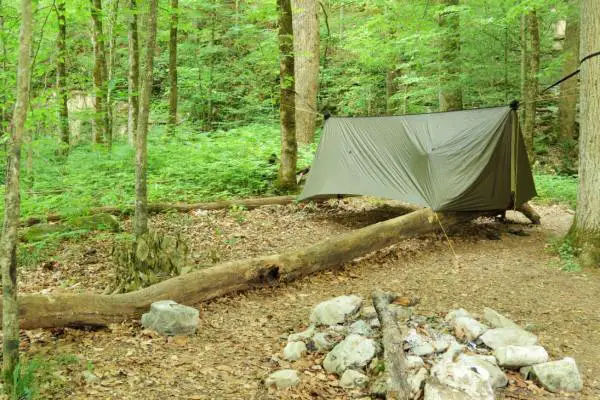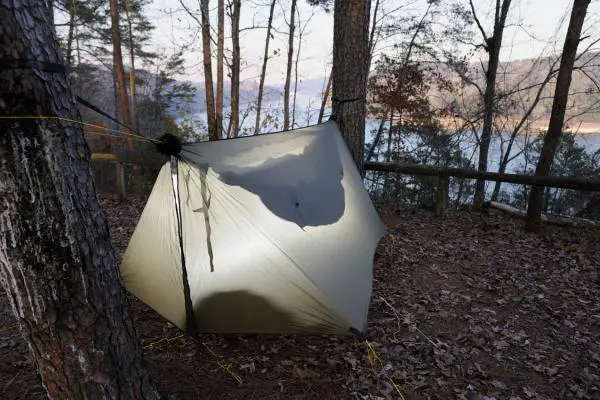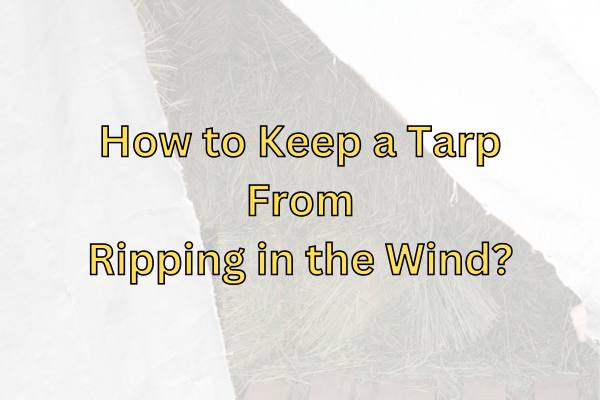Are you an outdoor enthusiast looking for ways to make camping activities more safe and enjoyable? Keeping a tarp from ripping in the wind can be challenging, but with some simple tips it doesn’t have to be.
To keep a tarp from ripping in the wind, consider the following options:
1. Choose a heavy-duty tarp: Select a tarp made from high-quality, durable materials like thick nylon, polyethylene or canvas with reinforced edges and strong grommets.
2. Proper anchoring: Secure the tarp using strong ropes, bungee cords, or ratchet straps. Attach them to the grommets and anchor them to sturdy objects like trees, poles, or stakes driven into the ground.
3. Use tarp clips: For additional support, use tarp clips or clamps to create more anchor points, especially along the sides of the tarp.
4. Avoid sharp edges: Ensure there are no sharp objects or edges underneath or around the tarp that could cause tearing.
5. Create a windbreak: If possible, set up a windbreak using natural elements like trees or bushes, or use a temporary structure like a fence or wall to reduce wind exposure.
6. Allow for some movement: Don’t secure the tarp too tightly, as some flexibility will help to distribute the wind force more evenly and prevent stress points.
7. Regularly inspect and maintain your tarp: Check the tarp and its anchor points regularly for signs of wear or damage, and make any necessary repairs or adjustments to prevent further damage.
8. Use multiple tarps: In extreme wind conditions, consider using multiple smaller tarps instead of one large tarp, as this can help distribute the wind force more evenly and reduce the risk of ripping.**
As an outdoor expert, I’d like to share my knowledge on how to protect your tarp against strong winds and keep your outdoor experience hassle-free.
With these techniques, you’ll save yourself time and money from having to constantly replace damaged tarps—all while enjoying the freedom of the outdoors without worry!
Read on for some practical advice that will help ensure you’re getting the most out of every outing.
Materials Needed
You may be wondering why you need to secure a tarp from the wind, when it’s already secured in place.
The truth is that even if your tarp is firmly placed, strong winds can still rip or tear it. You therefore need to tie it slightly looser than you would think as this leaves some room to give in before the tarp itself rips apart.

To keep your tarp protected and prevent any damage, you’ll want to use sturdy tie down materials like rope, bungee cords, or straps along with wind resistant fabrics like canvas or vinyl.
You’ll also want to pay attention to grommet placement and double stitching for extra reinforcement.
And lastly, don’t forget about using strong knots so that everything stays in place during gusts of wind.
All these elements will help ensure your tarp doesn’t get damaged by the wind.
Steps For Securing
When it comes to keeping a tarp from ripping in the wind, there are some essential steps you can take to ensure your tarp remains secure.
First and foremost, make sure you have all of the appropriate materials on hand. Tie down options such as bungee cords or rope will be necessary for securing your tarp to anchor points. Weatherproofing materials like duct tape or vinyl patches may also come in handy if you need additional reinforcement against inclement weather.
You’ll want to pay close attention to where you position your tarp and the direction of any existing wind patterns when staking it down with stakes or tent pegs.
Be mindful not only of how these items hold up in high winds but also which type of stake option works best depending upon what kind of surface they’re being driven into–whether that’s sand, grass, soil, etc.
If possible, try setting up two separate sets of tie downs so one acts as backup should the other fail during heavy gusts.
These simple measures add an extra layer of protection between your tarp and potentially damaging gusts while giving yourself peace-of-mind that everything is properly secured before heading out on your next outdoor adventure!
Taking a few moments ahead of time helps guarantee that no matter what Mother Nature throws at you, your gear stays safe and sound.
Strengthening Techniques
Strengthening techniques to keep a tarp from ripping in the wind are like building blocks that form an impenetrable wall against strong gusts.
As with any construction project, it’s important to start with a solid foundation by selecting the right fabric and weatherproofing materials.

Like a knight of old fortifying their castle walls, stitching techniques such as grommet reinforcement and knot tying can help you stand up against the elements.
Fabric selection is key when looking for a material to hold fast against high winds.
Make sure to purchase heavy duty fabrics that won’t easily tear or fray when exposed to tough conditions.
In addition, look for synthetic blends that include polyester, nylon or acrylic fibers – these will provide additional strength and durability no matter how turbulent the weather may be outside.
With your sturdy base in place, using grommets and rope loops along edges, corners and sides will give extra support to withstand buffeting blasts of air.
For added security, double-up on knots wherever possible – this will ensure everything stays firmly tied down no matter what Mother Nature throws at you!
Prevention Measures
Now that we have discussed some of the best strengthening techniques for tarp protection in windy conditions, let’s look at how to keep your tarp from ripping in the first place. Prevention is always better than a cure!
Here are four key steps you can take to ensure maximum prevention and longevity:
1. Invest in tie down options such as sandbags, stakes, or heavy rocks to anchor the edges of the tarp securely so it doesn’t flap about too much.
2. Weatherproofing methods like sealing seams with heat-seal tape or waterproof sprays will help keep moisture out and increase durability over time.
3. Windproofing tips include adding extra layers of fabric around areas where flapping could occur, creating additional anchors further away from the edge of the tarp, or by using large stones instead of pegs to secure corners.
4. Finally, make sure you store your tarp properly when it’s not in use – fold it carefully and store it indoors if possible; this prevents damage due to UV rays and other weather elements.
By keeping these simple steps in mind, you can rest assured knowing that your gear will remain safe and sound even during strong winds!
Frequently Asked Questions
What Size Tarp Should I Use?
When it comes to keeping your tarp from ripping in the wind, size certainly matters. A larger tarp will spread out the force of gusts and reduce stress on any one point; however, an overly large tarp can be difficult to manage and won’t provide much additional protection unless you also use other reinforcement options such as anchor points or weatherproofing methods.
Windproofing techniques are available for those who need a smaller tarp with extra strength. Reinforcement types like grommets and bungee cords can further secure your tarp against powerful winds.
Ultimately, choosing the right size for your needs is key when trying to keep a tarp from tearing apart under strong winds.
What Type Of Material Should I Use To Tie Down The Tarp?
When choosing the type of material to tie down your tarp, it’s important to remember that wind speed can increase exponentially with altitude. Knotting techniques, rope quality and anchor points are all essential when weatherproofing against gusts.
For example, Polypropylene is a great choice for tying up tarps due to its flexibility and strength – making it perfect for those seeking freedom in the outdoors.
So next time you’re looking to secure a tarp in strong winds, make sure to choose wisely!
How Often Should I Check The Tarp For Wear And Tear?
When it comes to protecting your tarp from the elements, checking for wear and tear is essential.
Regularly inspecting the tie-down materials and evaluating their weight capacity should be part of any outdoor enthusiast’s routine.
Make sure the wind protection you choose is up to date with the latest technology when selecting a tarp, as this will ensure that your investment lasts for years to come.
Frequency of inspection depends on how often you use and transport your tarp – check every few months if possible or after each major storm.
With proper selection and maintenance, you can keep your tarp in top shape while enjoying all that nature has to offer!
How Much Weight Can The Tarp Support?
As an outdoor expert, I can tell you that the strength of your tarp largely depends on the tie strength and rope strength used to secure it in place.
When using a tarp for windproofing, ensure that the knots are tight and able to withstand strong winds.
With proper knot tying techniques and enough weight placed on each corner, your tarp should be more than capable of enduring even the most blustery days.
A good rule of thumb is to use materials that are rated for at least 40 pounds; this will provide ample protection from gusts while giving you peace of mind knowing your equipment won’t go flying off into oblivion!
Are There Any Special Precautions I Should Take During High Winds?
When dealing with high winds, there are a few special precautions you should take to ensure your tarp won’t rip.
First and foremost, make sure the stake locations are secure; this will help prevent wind gusts from flapping or pulling at the fabric.
Additionally, pay attention to wind speed when setting up camp – if it’s too strong for the fabric quality of your tarp, consider other weatherproofing methods like using soft ties instead of hard knots.
With these steps in mind, you’ll be able to keep your tarp intact during even the toughest of breezes!
Conclusion
The wind can be a fierce force, so it’s important to take the necessary precautions when using tarps outdoors. With proper preparation and maintenance, your tarp will stay strong and secure even in the strongest of winds.
First, choose a tarp that fits the size of your project and use sturdy material for tying down the edges. Make sure to check regularly for signs of wear or damage due to weathering and replace any broken parts immediately. Take into account how much weight your tarp can support; too much strain can cause undue stress on its lifespan.
When high winds are forecasted, take extra steps to ensure your tarp is safe from breaking free. Consider adding additional stakes or weights around the perimeter if possible, as well as reinforcing all points with stronger ties than normal.
Additionally, you may want to consider anchoring the center of the tarp directly into the ground for added security.
With these tips in mind, I’m confident you’ll be able to keep your tarp from ripping in high winds! By taking proactive measures and scheduling regular inspections, you’ll enjoy peace of mind knowing that your hard work won’t be undone by Mother Nature’s gusts.




